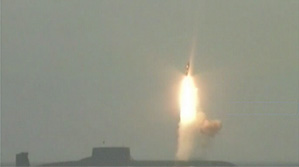| Tell a friend | Print version |
|---|
Bulava missile test: insistent mistake making?
Source: , author: RIA Novosti military commentator Ilya Kramnik Russian military plan to resume tests of the Bulava missile at the end of this year, a Navy Headquarters officer said.
Russian military plan to resume tests of the Bulava missile at the end of this year, a Navy Headquarters officer said.
The new ICBM is expected to enter service in 2009 along with the new submarine designed to carry this missile, the Borei-class Project 955 nuclear-powered undersea cruiser Yury Dolgoruky.
It is nevertheless clear that the Bulava, also known as R-30 in the Russian navy, 3M30 in the Main Missile/Artillery Directorate of the Defense Ministry, RSM-56 on the START treaty and SS-NX-30 NATO designation, hasn't met expectations so far, with four of the seven test launches failing and the last one "partly successful" according to official reports.
Specialists name a number of reasons for the trouble, which occurred in different phases of the missiles' flight, from the first minutes after the launch to the warhead dispensing, which indicates that the missile's components need further improvement. The initial cause is said to be that the Bulava development project was handed over to the Moscow Institute of Thermal Technology, which had never dealt in sea-based missiles.
The Bulava's defects can probably be eradicated, but this would take up to three years and 12 to 14 test launches, and therefore delay the entering into service of the Project 955 submarines, weakening Russia's strategic nuclear force, as seven Project 667BDR ballistic missile submarines will be decommissioned until mid-next decade. The latter were earlier scheduled to be gradually replaced by Project 955 submarines.
Meanwhile, the Russian navy maintains the 667BDRM submarines built in late 1990s and early 1990s and currently undergoing repairs and upgrades, with R-29RM missiles being replaced by R-29RMU2 Sineva ICBMs. The recent successful test-firing at a record distance of 11,547 km proved the high potential of the Makeyev Design Bureau, traditionally specializing in ballistic missile development.
As for the Sineva and Bulava missiles, it is clear that switching the naval missiles development to the Moscow Institute of Thermal Technology had been a mistake. The dubious advantage of unification with Topol-M missiles, which in fact is impossible neither in size, weight or appearance, set the development back years and led to huge spending, which is not sure to produce any significant effect. The Bulava's only advantage over Sineva is a shorter boost phase, which makes enemy interception more difficult.
The Sineva, however, has a significant advantage in throw-weight at 2,800 kg compared to the Bulava's 1,150 kg, and is also fitted with a more advanced penetration system. Additionally, a longer range of fire enables the submarines stay far away from NATO naval and anti-submarine aircraft bases.
A possible solution is to modernize the already afloat Yury Dolgoruky and its sister ships still in production and to equip them with Sineva missiles, whose diameter allows them to be fired from Bulava silos. The Sineva, however, is longer, which would require slightly higher silo enclosures installed.
A more serious obstacle could be that the Bulava is launched via a "dry start" with solid-state pressure accumulators, while the Sineva requires a preliminary filling of the launch tube with off-board waters.
This problem could be solved, however. Some sources say, the Makeyev Design Bureau has developed a Sineva version, which uses the "dry start" technology. If this version passes tests in the near future, the first Project 955 submarine armed with Sineva ICBMs could enter service in 2010.
Another advantage of the Sineva is its production maturity, enabling the manufacturer to launch its production fast and therefore replace the Project 667BDR submarines in time.
It is probably time to rectify mistakes.



